Critics of national health care models warn of British or Canadian situations, and they are correct to be suspicious of truly socialized medicine. Government commissions should not decide upon patients’ treatments. On the other hand, should insurance companies have the right to cut off treatments and end the coverage of high-risk patients, and operate as any other industry in a free society?
Health care may be the number one issue at the moment in America. Those who are left-of-center favor a “single payer” model, in which the federal government creates a new and frighteningly strong power as the keeper of the nation’s health. Those right-of-center want to keep the present system, which demands from the (lower) middle classes excessive chunks of their income.
Is there a third way? Is it possible for a mature and self-conscious society to organize national health care without unnecessarily limiting the freedoms of both the healthy and the sick?
Yes, it exists. The third way is the Dutch way — a functioning and greatly performing model that is regarded at the moment as the best answer to the question of universal health care.
The Netherlands has a population of only 16 million, but it nevertheless has the 16th biggest economy in the world. It is a perfectly organized and diverse society with well-educated citizens who, in the last decade, have been introducing the pressure of competition and the marketplace to their welfare state. They have renovated and redesigned their once “socialized” health care system.
And it works.
In the Dutch health care system, the essential module is the so-called Base Care Insurance (BCI), set by the government (and approved by parliament) and completely executed by private health insurance companies. This BCI — obligatory for every citizen — is financed by taxes and a personal monthly payment to the insurance company of choice (most of them offer extra items in their base package to attract business) of about 90 euros and a yearly deduction of 150 euros. Children under 18 are free.
The BCI covers everything a 21st century patient needs — including limitless visits to his own local GP of choice (who also can visit the patient at home), visits to specialists, surgery, transplants, medication, hospitalization, ambulance costs, ER costs, and the whole extended range of modern health care a wealthy society should be able to offer to its demanding citizens. And there are more options on top of this base level. As an individual citizen you are free to extend the vast care that already exists within the BCI with exotic therapies (like acupuncture), individual rooms in hospitals, a choice of menus, and IVF/ICSI treatments. A complete “luxury package” with dozens of perks for a family of four is being offered by insurance companies for under 400 euros per month, including the base fee.
This health care model costs about 9 percent of the GNP of the Netherlands — more than 6 percent cheaper than the American model. Life expectancy is 79.4 years; in the U.S. it is 78.11. Not only do the Dutch on average live longer, but the quality of life of their elderly easily beats that of Americans because of the easy access to excellent health care.
Because the state subsidizes the insurance companies, pre-existing conditions cannot be a reason to refuse an individual a BCI. Every citizen is covered. The GP and the specialist decide upon treatments and therapies, not the insurance company or the civil servant at the Department of Social Care (which implements this model). When waiting lists occur, they are the result of a temporarily high demand for certain treatments, not because of a number set by government for these treatments or due to an insurance company trying to maximize its profits. But if these lists happen, the insurance companies send patients to available hospital beds and specialists in neighboring countries (often Belgium and Germany, for most Dutchmen an approximately forty-minute flight or two-hour drive) for surgery or treatment.
The Dutch model was introduced in 2006 by Hans Hoogervorst of the VVD, the conservative-liberal party. It replaced a dualistic model of both national health care along British lines and a fully private health care along American lines. The new model combines the best of both concepts, with about 5 percent administrative costs (the U.S. is over 7 percent).
Opponents of national health care in America should carefully study this Dutch treat. It leaves every citizen the freedom to pick his own doctor and his own care, but it denies him — let us be clear about this — the freedom to be uninsured. In this regard, he has no choice. It works as any insurance: When the individual is healthy, through his taxes he is co-financing the costs of the sick. The older he gets, the higher the chance that he needs expensive medical care, and the healthy will co-finance his costs. It is a perfect system as long as a nation has enough young, healthy citizens — the threat is a “graying” of the population.
After its introduction, the base care insurance led to an increase of waiting lists, but they were forced down in a short period of time by market mechanisms — the insurance companies had to deliver fast and efficient care in order to keep their clients. Also, in hospitals, because of the pressure of market mechanisms, overheads got tighter and service faster. There hasn’t been a drop in the income of GPs, specialists, and nurses, nor has there been a decrease in the number of students applying to study medicine or to work in the health sector. There is no limitation in the freedom of doctors to remain independent or to be employed by a hospital. Because of market mechanisms and the monitoring capacities of the government, there is increased transparency in costs and the allocation of subsidized funds. And because of the competition among insurance companies, their plans tend to offer more items in extended packages.
In modern civilized societies, we have created institutions to limit the dangers for citizens who pursue happiness. We pay for a police force, for fire brigades, for army engineers who build dams and protect us against floods, for sewers and clean water. But in the United States of America, the most prosperous nation in human history, a highly regulated and heavily bureaucratic country, there is no institution that regulates how citizens should receive treatment when a dramatic interference in their physical existence occurs. Opponents of national health care warn of dangerous waiting lists, the misuse of patients’ data by an evil government, of draconic limits on care for the elderly. These are all serious dangers, and it would be unwise to deny them.
But there is an alternative. In the Netherlands, it is impossible to lose health care when losing a job. Bankruptcy from high medicine and hospital bills cannot occur. The BCI creates a high degree of individual security and a sense of a common responsibility without the burden of ceilings in the number of treatments set by bureaucrats or by the profit margins of insurance companies.
The Netherlands isn’t a perfect society. Its social and cultural permissiveness is often mindless. But its health care model is reasonable, more or less affordable, and leaves citizens the freedom to choose.
We tend to question the main body of President Obama’s policies, but we appreciate his ambition to introduce universal health care in America. It should not be opposed with catastrophic examples taken from the black book of the British health care system or with the argument that officials of the U.S. government will decide upon your recovery schedule after surgery or the kind of medication you can get. A civilized nation should find honor in offering all of its citizens the best health care for the best price — the Dutch are delivering.
We kindly advise President Obama and the U.S. Congress to adopt the Dutch model. It is possible to have a highly modern health care system based upon reason and individual interests and choices. This would eliminate the fear in America that a serious illness can destroy — both emotionally and financially — the future of whole families.









Join the conversation as a VIP Member